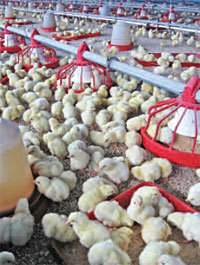



Is This the Year When Consumers Become Healthy, Wealthy and Wise?
Food retailers and brands are faced with a myriad of new challenges: sustainability, transparency, undeniable price increases and the continued search for the Holy Grail that will lead us to health and wellness. US 'Supermarket Guru', Phil Lempert analyses what the challenges will mean in this article published by Cobb-Vantress.It is often said that trends start on both coasts, and that if you want to see the future look in New York and in California. But when it comes to food trends, I would have to say that the crystal ball in January of 2008 is glimmering in sunshine and on the beaches of the West Coast. 2007 has been a tumultuous food year: product recalls, fear of imported foods, even more confusing diet studies and a new retailer that challenges conventional merchandising. So let's take a quick look into exactly which trends will have an impact on the food world in 2008.

food columnist, author, and television and radio news reporter. He has gained wide acclaim for his marketing savvy and broad experience in the food industry. The 'Supermarket Guru', he is a respected analyst with an uncanny ability to identify and explain trends to both industry and consumers in a thought provoking and entertaining manner.
Trend 1: It's All About the Garbage
It is not about local versus organic, although that seems to be where most of the debate still rests. We need to look at the larger picture and develop a more long-term plan. Most retailers and brands care about the planet, perhaps even more than their customers. But whether it is about being green, figuring out how to measure the global footprint for your products and production facilities or just trying to reduce waste, 2008 will clearly be driven by the headlines that measure garbage. With cities and states working on legislation to tax or prohibit certain kinds of food and beverage packaging, retailers have the opportunity to take a lead position and build relationships with the shoppers around sustainability initiatives.
It was Tuesday, November 20, 2007 that San Francisco once again took a leap into the future of the food world. Northern California has given us Alice Walters and Chez Panisse, Tiburon's cutting edge ban on Trans Fats and now the nation's first ban on plastic grocery bags.
It was almost three years ago that the city's Board of Supervisors considered a 17 cent tax on each petroleum-based plastic grocery bag to force supermarkets and drug stores to use alternative materials that would have less of an impact on the environment and landfills. In San Francisco alone, last year there were about 180 million plastic shopping bags distributed - which, according to the San Francisco Department of the Environment and Worldwatch Institute, took roughly 774,000 gallons of oil to produce. In a deal with the California Grocers Association, the Board of Supervisors agreed to not impose the tax if large supermarkets would reduce the amount of bags given to shoppers in 2006 by 10 million bags, just a little over 5 percent of the total. Two years later that didn’t happen - so the ban took effect.
It appears that 2008 will be the year that being green is in, hip and becomes mainstream. It seems that the ground swell against plastic beverage bottles, plastic bags and plastic packaging in general will finally force a change for the good of our planet.

Retailers and brands cannot lose by taking a strong and vocal position to help clean up their cities. The time has come to learn from the past: retailers quickly embraced eliminating foods with trans-fats from their shelves, perhaps it is time to put in place universal guidelines for all products that are sold from our stores that include packaging quantity and materials as well as highlighting those companies that have favorable sustainable and footprint stories.
Trend 2: Where Did This Product Come From?
On the heels of a scathing report that not only questioned the systems and ability of the Food and Drug Administration on food safety but also reinforced the fragility of the consumer’s image of our food supply, this year must be the year that confidence in our food supply is restored.
Last fall, the third largest food retailer in the world, decided to cross the Atlantic and come to America! In their initial rollout on the West Coast, Tesco introduce a new concept: Fresh & Easy, a 10,000 square foot store that is 50 percent store brand, and has a focus on freshly prepared foods, fresh meats and fresh produce along with typical grocery SKUs. In the UK, they pioneered transparency well before Mad Cow {BSE} outbreaks, and built a strong customer relationship based on food safety reliability and trust.
Their stores will no doubt force the industry to install similar systems which will enable the retailer in seconds to track an individual product's path from farm to table with all the details necessary to determine a product's safety. Consumers are no longer accepting of the current way the food world and government is doing business: delays of weeks before we hear about millions of pounds of ground beef contaminated with E. coli, more than half a year to track a cow with Mad Cow Disease, and still waiting a year later for the final report on how bagged spinach with E. coli made it to our stores' shelves.
 |
Imported foods, whether they are from China or elsewhere, will have to not only meet the US standards, but be delivered with guaranteed inspections to have our shoppers' confidence. The Farm Bill, after months of stalling and conjecture, seems to be finally on track and will make Country of Origin Labeling (COOL) a reality, which is bringing smiles to the faces of many of our nation’s farmers and producers.
Trend 3: It's HOW Much?
According to the USDA Economic Research Service, the average American spends just 10 percent of our household budget on food. When we look in context and analyze other developed nations, we clearly see that we do have the cheapest food prices. And, yes, I will be roundly criticized; perhaps that's a bad thing.
France, known for its food indulgences and passion, spends almost double - 18 percent, and the UK shopper spends even more, 22 percent. Japan, which is known for its stringent food safety and beef testing has its citizens spending 26 percent of their hard earned money on their foods and the country that many look to as one of this century's developing business and technology leaders, India, finds residents spending just over half of their income to eat.
I am not suggesting that we run out and increase our prices. What I am suggesting is that the drive to have the 'cheapest food supply on Earth' is old-school and needs to be forgotten. We need to first shift our resources and produce foods and ingredients where we can ensure the proper nutrients and safety procedures are in place - hopefully that occurs on American soil.
Second, we need to stop putting pressure on brands for a lower price. Pushing on price does not allow for production or product innovation. When retailers demand stripping out 'waste' in a producer's system, that does not mean lowering profits. It typically results in short budgeting on good manufacturing practices which can lead to pushing production volumes and sanitation practices to its outer limits, which could lead to disaster.
And it can be done. In the two years of speculation about just what Tesco's new retail format here in the US was all about, much was said about healthy foods, prepared foods, fresh foods and of course Tesco's unwavering demand for transparency and traceability. But not too much was said about price.
When Tim Mason, Fresh & Easy CEO, kicked off their US arrival in November it was at a rather pedestrian location - 4211 Eagle Rock Boulevard in Los Angeles. A neighborhood of middle to lower middle class Angelinos that include a mix of Hispanics, seniors, African Americans and Caucasians. During his six-minute welcoming speech, Mason stressed how he and his senior team has spent the past two years getting to understand the needs of the American shopper and how these stores are a perfect match to those needs; while consistently reinforcing their commitment to everyday low prices.
Mason and his team actually seem to understand the shopper far better than their competitors. With no preconceived notions or agendas, they came to California with a single focus and that was to create the next channel to sell food. And they have done exactly that: a smaller footprint store that is highly efficient to operate offering fresh, healthy and prepared foods at everyday low prices. Simon Uwins, F&E chief marketing officer, shared their strategy, "Fresh wholesome foods at prices everyone can afford" and their initial locations stand as proof. While the residents of Malibu or Santa Monica might have seemed on the surface a more logical target for the store, its offerings, and the PR-ability, it appears that F&E has its sights focused on attracting a much larger, and perhaps more loyal, customer base.
Trend 4: The 'Bad' Idea of Nutrition Rating Systems
You might have expected this trend to start in Hollywood - imagine adding health ratings to food. How LA! But it was a little over a year ago, Hannaford Supermarkets rolled out the 'Guiding Stars' program in the Northeast, a program designed to help us shoppers make better and healthier choices as we shopped down their stores' aisles. The program awards one, two or three stars representing 'good', 'better' or 'best' in terms of nutritional value.
 |
The program seems to be working. Sales in the first year of 'Guiding Stars' found that leaner beef sales increased while fattier beef sales declined. Whole milk sales down, fat-free milk sales up. Some of the greatest improvements were seen in grocery items - cereal, bakery, canned products and snack foods - these on average grew at 2.5 times the rate of those with no stars. A little over 25 percent of the products on Hannaford's shelves carry at least one star.
So why don't I like the program?
It's not about the concept; it may well be a good idea but it is adding confusion to our customers’ shopping trips.
Late last year, another nutritional guidance system, called the Overall Nutritional Quality Index (ONQI), which is headed by Dr David L. Katz, director of the Yale-Griffin Prevention Research Center, was unveiled. Their ratings are based on a 0 to 100 score. Their program is based on measuring 'approximately 30 nutrients, both those with favorable health effects such as fiber, and those with unfavorable health effects such as added sugar, are included in the sophisticated ONQI formula, which also includes a variety of weighting coefficients that reflect the importance of various nutrients to health, and their associations with specific health outcomes'.
The confusion comes in as we shoppers are faced with different ratings and I'm sure we will see at least a couple more make their ways on the shelves, which use different criteria and different symbols. How do you compare ‘3 Stars’ with a score of ‘93’? Which is better?
I have little doubt that the only way that such programs will benefit the shopper (versus benefiting only the stores or brands that tout them) is to have one consistent rating system that is developed through a coalition of government and trade groups who come to agreement on the criteria and make it universal. Otherwise, these just become more labels that add more confusion.
Trend 5: Relationships
 |
The one trend that continues year after year is Trend 5. It is all about relationships: relationships with our farmers, our suppliers, our peers, our associates and most importantly, the relationships with our fellow shoppers.
There is little doubt that as we progress into the future, there must be 'business sustainability' towards the planet’s resources as well as towards other businesses that we operate with in concert. For any of us to succeed, we all must succeed.








